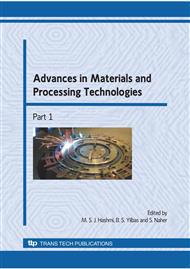[1]
Hodgson, T., Trendler, P. H. H., and Michelletti, G. F, Turning hardened Tool Steels with Cubic Boron Nitride Inserts, Annals of CIRP, Vol. 30(1), pp.63-66, (1981).
DOI: 10.1016/s0007-8506(07)60896-8
Google Scholar
[2]
Özel, T., and Karpat, Y., Predictive Modeling of Surfsce Roughness and Tool Wear in Hard Turning Using Regression and Neural Networks, International Journal of Machine Tools and Manufacture, 45, pp.467-479, (2005).
DOI: 10.1016/j.ijmachtools.2004.09.007
Google Scholar
[3]
Zeren, E., and Özel, T, Hard Turning Technology, Report No. MARL-01, Rutgers, The State University of New Jersey, (2002).
Google Scholar
[4]
Koenig, W., Berktold, A., and Koch, F., Turning Versus Grinding-A Comparison of Surface Integrity Aspects and Attainable Accuracies, Annals of the CIRP, Vol. 42(1), pp.39-43, (1993).
DOI: 10.1016/s0007-8506(07)62387-7
Google Scholar
[5]
Chou, Y., Evans, C., and Barash, M., Experimental Investigation on CBN Turning of Hardened AISI 52100 Steel, Journal of Materials Processing Technology, 124, pp.274-283, (2002).
DOI: 10.1016/s0924-0136(02)00180-2
Google Scholar
[6]
Matsumoto, y., Barash, M., Review on Cutting Technology of Hard Materials, Proceedings of the Sixth International Conference on Production Engineering, Osaka, Japan, pp.116-122, (1987).
Google Scholar
[7]
Barbacki, A., Kawalec, M., and Hamrol, A., Turning and Grinding as a Source of Microstructural Changes in the Surface layer of Hardened Steel, Journal of Materials Processing Technology, 133, pp.21-25, (2003).
DOI: 10.1016/s0924-0136(02)00211-x
Google Scholar
[8]
Dawson, T. G., Machining Hardened Steel with Polycrystalline Cubic Boron Nitride Cutting Tools, Ph. D. Thesis, Georgia Institute of Technology, (2002).
Google Scholar
[9]
Liu, M., Takagi, J., and Tsukuda, A., Effect of Tool Nose Radius and Tool Wear on Residual Stress Distribution in Hard Turning of Bearing Steel, Journal of Materials Processing Technology, 150, pp.234-241, (2004).
DOI: 10.1016/j.jmatprotec.2004.02.038
Google Scholar
[10]
Chou, Y. K., Song, H., Thermal Modeling for Finish Hard Turning Using A new Tool", ASME Paper No. IMECE 2003-41765, Proceedings of IMECE, 03, Washington, D. C., (2003).
DOI: 10.1115/imece2003-41765
Google Scholar
[11]
O'Sullivan, D., Cotterell, M., Temperature Measurement in Single Point Turning, Journal of Materials Processing Technology, 118, pp.301-308, (2001).
DOI: 10.1016/s0924-0136(01)00853-6
Google Scholar
[12]
Huang, Y., and Liang, S.Y., Cutting Forces Modeling Considering the Effect of Tool Thermal Property- Application to CBN Hard Turning, International Journal of Machine tools and Manufacture, 43, pp.307-315, (2003).
DOI: 10.1016/s0890-6955(02)00185-2
Google Scholar
[13]
Thiele, J. D., Melkote, S. N., Effect of Cutting Edge Geometry and Workpiece Hardness on Surface Generation in the Finish Hard Turning of AISI 52100 Steel, Journal of Materials Processing Technology, 94, pp.216-226, (1999).
DOI: 10.1016/s0924-0136(99)00111-9
Google Scholar
[14]
Matsumoto, Y., Hashimoto, F., Lahoti, G., Surface Integrity Generated by Precision Hard Turning , Annals of the CIRP, Vol. 48, pp.63-66, (1999).
DOI: 10.1016/s0007-8506(07)63131-x
Google Scholar
[15]
Ávila, R. F., Abrão, A. M., The Effect of Cutting Fluid on the Machining of Hardened AISI 4340 Steel, Journal of Materials Processing Technology, 119, pp.21-26, (2001).
DOI: 10.1016/s0924-0136(01)00891-3
Google Scholar
[16]
Lima, J. G., Ávila, R. F., Abrão, A. M., Faustino, M., and Paulo Davim, J., Hard Turning: AISI 4340 High Strength Low Alloy Steel and AISI D2 Cold Work Tool Steel, Journal of Materials Processing Technology, 169(3), pp.388-395, (2005).
DOI: 10.1016/j.jmatprotec.2005.04.082
Google Scholar
[17]
Bailey, S. Jeelani and S. E. Becker, "Surface Integrity in Machining AISI 4340, Journal of Engineering for Industry, 98(3), pp.999-1007, (1976).
DOI: 10.1115/1.3439063
Google Scholar
[18]
Matsumoto, Y., Barash, M., Liu, C. R., Effect of Hardness on the Surface Integrity of AISI 4340 Steel, Journal of Engineering for Industry, 108, pp.169-175, (1986).
DOI: 10.1115/1.3187060
Google Scholar
[19]
Guo, Y. B. and Liu, C. R., 3D FEA Modeling of Hard Turning, ASME Journal of Manufacturing Science and Engineering, 124, pp.189-199, (2002).
DOI: 10.1115/1.1430678
Google Scholar
[20]
Ng, E. -G., Aspinwall, D.K., Brazil, D., and Monaghan, J., Modeling of Temperatures and Forces When Orthogonally Machining Hardened Steel, International Journal of Machine Tools and Manufacture, 39, pp.885-903, (1999).
DOI: 10.1016/s0890-6955(98)00077-7
Google Scholar
[21]
Chou, Y. K., Evans, C. J., White Layers and Thermal Modeling of Hard Turned Surfaces, International Journal of Machine Tools and Manufacture, 39, pp.1863-1881, (1999).
DOI: 10.1016/s0890-6955(99)00036-x
Google Scholar
[22]
Narutaki, N., Yamane, Y., Tool Wear and Cutting Temperature of CBN Tools in Machining of Hardened Steels, , Annal of the CIRP, Vol. 28(1), pp.23-28.
Google Scholar
[23]
Mahav S. Phadke, Quality Engineering using Robust Design, Prentice-Hall International Inc., Englewood Cliffs, NJ, (1989).
Google Scholar
[24]
Taguchi, G., Introduction to Quality Engineering, Asian Productivity Organization, Tokyo, Japan, (1990).
Google Scholar
[25]
Montgomery, D.C., Design and Analysis of Experiments, John Wiley & Sons Inc., New York, (2000).
Google Scholar
[26]
Liu, X. L., Wen, D. H., Li, Z. J., Xiao, L., Yan, F. G., Cutting Temperature and Tool Wear of Hard Turning Hardened Bearing Steel, Journal of Material, (2002).
DOI: 10.1016/s0924-0136(02)00651-9
Google Scholar


